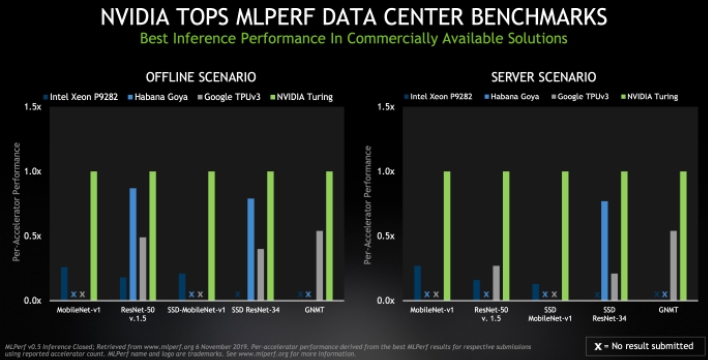NVIDIA Claims MLPerf AI Benchmark Dominance, Unveils Tiny Jetson Xavier NX AI Edge Supercomputer
To that end, NVIDIA says that the one-two punch of its Turing-based AI accelerators and the Xavier SoC allowed it to take top honors in all five of MLPerf's inference benchmarks. For its Turing offerings (with a focus on data centers), the Turing GPUs were able to top the charts in both server and offline scenarios on a "performance per processor" basis. Xavier (edge scenarios) took the crown single- and multi-stream benchmarks.
The MLPerf benchmarks put a focus on key operations including image classification, object detection and translation. It should be noted, however, that many of NVIDIA's wins were by default, as there were no results submitted by its competitors in a number of benchmarks. There may be specific reasons for the other competitors not to submit, but one can only speculate at this time.
As the MLPerf data center benchmark show, Turing tops the charts in all five benchmarks. In the one benchmark where results were submitted for all challengers -- ResNet-50 v.1.5 (Offline) -- Turing faced the stiffest competition from the Habana Goya, while doubling performance of the Intel Xeon P9282.
Moving on the MLPerf Edge SoC benchmarks, Xavier creamed the field -- which included Qualcomm Snapdragon 855 and Intel Core i3-1005G1 -- in per-accelerator performance with the single-stream MobileNet-v1 and ResNet-50 v.1.5 benchmarks. The multi-stream scenarios were won by Xavier by default, as no results were submitted for the two competing chips.
A New, More Compact NVIDIA Jetson Xavier Takes Flight
In other news, NVIDIA today announced the arrival of the Jetson Xavier NX, which is being billed as the "World's smallest supercomputer" for Edge AI computing. The actual Xavier NX module is roughly the size of a credit card, as you can see it compared below to a LEGO likeness of NVIDIA CEO Jensen Huang.

Getting down to brass tacks, NVIDIA says that the Jetson Xavier NX delivers up to 14 TOPs performance for AI workloads all while staying within a power budget of 10 watts. If power is ramped to 15 watts, performance climbs to 21 TOPs. Jetson Xavier NX is comprised of a hexa-core 64-bit Arm processor, NVIDIA Volta GPU (348 CUDA cores, 48 Tensor cores), 8GB LPDDR4x, GbE, and support for up to six CSI cameras.
NVIDIA envisions Jetson Xavier NX being used for robotics, aerial drones, medical sensors and in factory for image processing (see yesterday's NVIDIA-USPS announcement). “AI has become the enabling technology for modern robotics and embedded devices that will transform industries,” explained Deepu Talla, vice president and general manager of Edge Computing at NVIDIA.

“Many of these devices, based on small form factors and lower power, were constrained from adding more AI features. Jetson Xavier NX lets our customers and partners dramatically increase AI capabilities without increasing the size or power consumption of the device.”
NVIDIA is pricing Jetson Xavier NX at $399, and it will be available in March 2020.




